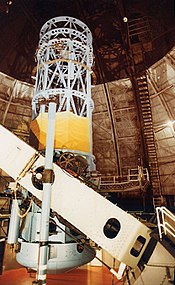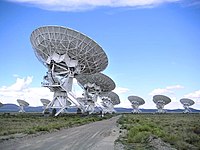| Revision as of 04:08, 23 July 2008 editFountains of Bryn Mawr (talk | contribs)Extended confirmed users22,031 edits Undid revision 227328349. Still not a summery of History page. Don't delete reflector material. uncivil comments noted.← Previous edit | Revision as of 06:11, 23 July 2008 edit undoInternetHero (talk | contribs)2,457 editsm Ok, sry about the "bigot" comment. Nevertheless, Al-Haytham is fundamental to the telescope.Next edit → | ||
| Line 6: | Line 6: | ||
| {{main|History of telescopes}} | {{main|History of telescopes}} | ||
| The history of the telescope dates back to the beginning of the ] century with ]'s ] which descibed the first magnifying device to be used in an ''instrument''.<ref name= Sabra2>Sabra, A. I. & Hogendijk, J. P. (2003), The Enterprise of Science in Islam: New Perspectives, MIT Press, pp. 85-118, ISBN 0262194821</ref> His descriptions in the ''Book of Optics'' helped set the parameters in ] for the later advances in telescopic and microscopic technology,<ref>O. S. Marshall (1950). "Alhazen and the Telescope", Astronomical Society of the Pacific Leaflets 6, p. 4</ref><ref>] (University of Illinois), Best Idea; Eyes Wide OpenNew York Times, April 18, 1999.</ref>but the first known practically functioning telescope is credited to the German-Dutch lensmaker ] in ]. | |||
| The history of the telescope dates back to the their invention in the beginning of the ] century. In the ], the properties of lenses and mirrors as image forming devices had been known since antiquity and had been studied widely in the centuries preceding the telescopes development. Although there were some recorded instances of pre-17th century ] and ] opticians creating devices that could have functioned as telescopes, the earliest known working telescopes in the modern sense were ]s that appeared in the ] in ]. These were credited to three individuals, ] and ], spectacle-makers in Middelburg, and ] of ] also known as Jacob Adriaanszoon.. ] greatly improved upon this design the following year. ] is credited with constructing the first telescope to use mirrors, a ], in 1616. In 1668 ] designed an improved reflecting telescope that bares his name, the ]. | |||
| The invention of the ] in 1733 that corrected some of the color aberration of simple lenses allowed for more functional shorter refracting telescopes. Reflecting telescopes, although not limited by the color problems seen in refractors, were limited in their usefulness due to the fast tarnishing ] mirrors used during the 18th and 19th centuries. The introduction of silver coated glass mirrors in 1857<ref></ref>, aluminized mirrors in 1932<ref>[http://www.cambridge.org/uk/astronomy/features/amateur/files/p28-4.pdf Bakich sample pages Chapter 2, Page 3 ''"John Donavan Strong, a young | The invention of the ] in 1733 that corrected some of the color aberration of simple lenses allowed for more functional shorter refracting telescopes. Reflecting telescopes, although not limited by the color problems seen in refractors, were limited in their usefulness due to the fast tarnishing ] mirrors used during the 18th and 19th centuries. The introduction of silver coated glass mirrors in 1857<ref></ref>, aluminized mirrors in 1932<ref>[http://www.cambridge.org/uk/astronomy/features/amateur/files/p28-4.pdf Bakich sample pages Chapter 2, Page 3 ''"John Donavan Strong, a young | ||
Revision as of 06:11, 23 July 2008
For other uses, see Telescope (disambiguation).
A telescope is an instrument designed for the observation of remote objects and the collection of electromagnetic radiation. The first known practically functioning telescopes were invented in the Netherlands in the beginning of the 17th century. The name "Telescope" (from the Greek tele = 'far' and skopein = 'to look or see'; teleskopos = 'far-seeing') was invented by an unidentified Greek poet/theologian, present at a banquet held in 1611 by Prince Federico Cesi. It was given to a version of the instrument constructed by Galileo Galilei. "Telescope" can refer to a whole range of instruments operating in most regions of the electromagnetic spectrum.
History
Main article: History of telescopesThe history of the telescope dates back to the beginning of the 11th century century with Ibn Al-Haytham's optical research which descibed the first magnifying device to be used in an instrument. His descriptions in the Book of Optics helped set the parameters in Europe for the later advances in telescopic and microscopic technology,but the first known practically functioning telescope is credited to the German-Dutch lensmaker Hans Lippershey in 1608.
The invention of the achromatic lens in 1733 that corrected some of the color aberration of simple lenses allowed for more functional shorter refracting telescopes. Reflecting telescopes, although not limited by the color problems seen in refractors, were limited in their usefulness due to the fast tarnishing speculum metal mirrors used during the 18th and 19th centuries. The introduction of silver coated glass mirrors in 1857, aluminized mirrors in 1932, and the maximum physical size limit of the refracting telescope objectives, at around 1 meter (40 inches), meant almost all of the large research telescopes built since the turn of the 20th century have been reflectors.
The 20th century also saw the development of telescopes that worked in wide range of wavelengths from radio to gamma-rays. The first radio telescope went into operation in 1937. Since then a tremendous variety of complex astronomical instruments have been developed.
Types of telescopes
| This article needs additional citations for verification. Please help improve this article by adding citations to reliable sources. Unsourced material may be challenged and removed. Find sources: "Telescope" – news · newspapers · books · scholar · JSTOR (July 2008) (Learn how and when to remove this message) |
The name "telescope" covers a wide range of instruments and is difficult to define. They all have the attribute of collecting electromagnetic radiation so it can be studied or analyzed in some manner. The most common type is the optical telescope. Other types also exist and are listed below.
Optical telescopes

An optical telescope gathers and focuses light mainly from the visible part of the Electromagnetic spectrum (although some work in the infrared and ultraviolet). Optical telescopes increase the apparent angular size of distant objects, as well as their apparent brightness. Telescopes work by employing one or more curved optical elements - usually made from glass - lenses or mirrors - to gather light or other electromagnetic radiation and bring that light or radiation to a focus, where the image can be observed, photographed, studied, or sent to a computer. Optical telescopes are used for astronomy and in many non-astronomical instruments, including: theodolites (including transits), spotting scopes, monoculars, binoculars, camera lenses, and spyglasses. There are three main types:
- The refracting telescope which uses lenses to form an image.
- The reflecting telescope which uses an arrangement of mirrors to form an image.
- The catadioptric telescope which uses mirrors combined with lenses, in front of the mirror or somewhere within the optical path, to form an image.
Radio telescopes
Main article: Radio telescope
Radio telescopes are directional radio antennas that often have a parabolic shape. The dishes are sometimes constructed of a conductive wire mesh whose openings are smaller than the wavelength being observed. Multi-element Radio telescopes are constructed from pairs or larger groups of these dishes to synthesize large "virtual" apertures that are similar in size to the separation between the telescopes: see aperture synthesis. As of 2005, the current record array size is many times the width of the Earth, utilizing space-based Very Long Baseline Interferometry (VLBI) telescopes such as the Japanese HALCA (Highly Advanced Laboratory for Communications and Astronomy) VSOP (VLBI Space Observatory Program) satellite. Aperture synthesis is now also being applied to optical telescopes using optical interferometers (arrays of optical telescopes) and Aperture Masking Interferometry at single reflecting telescopes. Radio telescopes are also used to collect microwave radiation, often used to help study the leftover Big Bang radiation, and also can be used to collect radiation when visible light is obstructed or faint, such as from quasars. Some radio telescopes are used by programs such as SETI and the Arecibo Observatory to search for exterrestrial life. (see also: Wow! Signal)
X-ray and gamma-ray telescopes
Main articles: X-ray astronomy and gamma-ray astronomyX-ray and gamma-ray radiation go through most metals and glasses, some X-ray telescopes use Wolter telescopes composed of ring-shaped "glancing" mirrors, made of heavy metals, that reflect the rays just a few degrees. The mirrors are usually a section of a rotated parabola and a hyperbola or ellipse. Gamma-ray telescopes refrain from focusing completely, and use coded aperture masks; the pattern of shadows the mask creates can be reconstructed to form an image.
These types of telescopes are usually on Earth-orbiting satellites or high-flying balloons, since the Earth's atmosphere is opaque to this part of the electromagnetic spectrum.

Other types
Notable telescopes
- Anglo-Australian Telescope
- Arecibo Observatory
- Atacama Large Millimeter Array
- Chandra X-ray Observatory
- CHARA (Center for High Angular Resolution Astronomy) array
- Giant Metrewave Radio Telescope
- Great Paris Exhibition Telescope of 1900
- Hale telescope 1948, 200" reflector, Mount Palomar
- Hexapod-Telescope
- Hooker Telescope 1917, 100" reflector, Mount Wilson
- Hubble Space Telescope
- IceCube Neutrino Detector
- Isaac Newton Telescope
- Keck telescope
- Leviathan of Parsonstown 1849, 79" reflector, Birr, Ireland
- Lick Observatory
- LIGO
- Lovell Telescope
- McMath-Pierce Solar Telescope
- McMath-Hulbert Observatory (Solar)
- Magdalena Ridge Observatory
- Multiple-Mirror telescope
- Navy Prototype Optical Interferometer
- Overwhelmingly Large Telescope (proposed)
- Parkes Observatory
- Southern African Large Telescope
- Subaru Telescope
- UK Schmidt Telescope
- Very Large Array
- Very Large Telescope
- Westerbork Synthesis Radio Telescope
- William Herschel Telescope
- XMM-Newton
- Yerkes 1897, 40" largest optical refractor
| This list is incomplete; you can help by adding missing items. |
See also
- Timeline of telescope technology
- History of telescopes
- Amateur telescope making
- Angular resolution
- Aperture synthesis
- ASCOM open standards for computer control of telescopes
- BOOTES
- Depth of field
- Dynameter
- Eyepiece
- First light
- f-number
- Keyhole problem
- List of largest optical reflecting telescopes
- List of largest optical refracting telescopes
- Microscope
- Nimrud lens
- Remote Telescope Markup Language
- Robotic telescope
- Space observatory
Notes
- omni-optical.com "A Very Short History of the Telescope"
- Sabra, A. I. & Hogendijk, J. P. (2003), The Enterprise of Science in Islam: New Perspectives, MIT Press, pp. 85-118, ISBN 0262194821
- O. S. Marshall (1950). "Alhazen and the Telescope", Astronomical Society of the Pacific Leaflets 6, p. 4
- Richard Powers (University of Illinois), Best Idea; Eyes Wide OpenNew York Times, April 18, 1999.
- madehow.com - Inventor Biographies - Jean-Bernard-Léon Foucault Biography (1819-1868)
- [http://www.cambridge.org/uk/astronomy/features/amateur/files/p28-4.pdf Bakich sample pages Chapter 2, Page 3 "John Donavan Strong, a young physicist at the California Institute of Technology, was one of the first to coat a mirror with aluminum. He did it by thermal vacuum evaporation. The first mirror he aluminized, in 1932, is the earliest known example of a telescope mirror coated by this technique."]
References
- Contemporary Astronomy - Second Edition, Jay M. Pasachoff, Saunders Colleges Publishing - 1981, ISBN 0-03-057861-2
- Sabra, A. I. & Hogendijk, J. P. (2003), The Enterprise of Science in Islam: New Perspectives, MIT Press, pp. 85-118, ISBN 0262194821
External links
- "The First Telescopes". Part of an exhibit from Cosmic Journey: A History of Scientific Cosmology by the American Institute of Physics
- ESO 100 m telescope
- The Resolution of a Telescope
- Southern African Large Telescope (SALT)
- The Digges telescope of the 1570s
- The Swedish Solar telescope
- History of Refracting Telescope